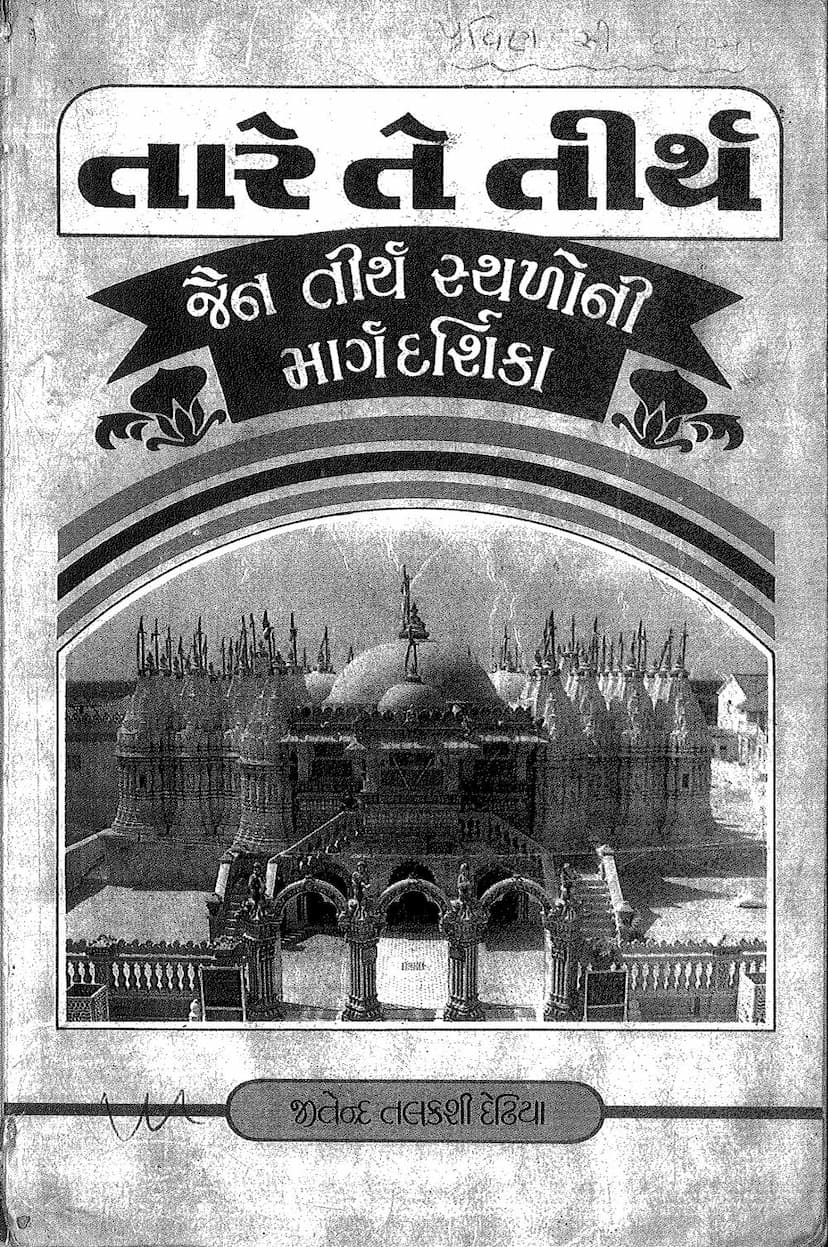Tare Te Tirth
Added to library: September 2, 2025

Summary
This is a comprehensive summary of the Jain text "Tare Te Tirth" (Where There is Faith, There is a Pilgrimage), compiled by Jitendra Tilakshi Dedhia. Published by Mahendra Kanji Gosar, this book serves as a guide to Jain pilgrimage sites.
Overall Purpose:
The primary objective of "Tare Te Tirth" is to provide travelers with easily accessible and necessary information about popular Jain pilgrimage sites. The second edition aims to improve upon the first by incorporating feedback, suggestions, and expanding the scope of information provided.
Key Content and Features:
The book is a detailed directory of Jain Tirth (pilgrimage) locations across various states in India, and potentially beyond. It includes:
- Extensive Listing of Tirthas: The table of contents and the detailed pages reveal a vast number of Tirthas organized by state, and within states, by location.
- Information Provided for Each Tirtha: For each pilgrimage site, the book typically includes:
- Original Name of the Moolnayak (Principal Deity): The name of the main deity (Tirthankar) enshrined in the temple.
- Color and Posture: Details about the idol's color and posture (e.g., white, seated).
- Origin and History: Information about the antiquity of the site, legends associated with it, historical figures involved in its construction or renovation (kings, ministers, merchants), and significant events.
- Architectural and Artistic Significance: Descriptions of the temple's architecture, sculptures, carvings, and any unique artistic features.
- Miracles and Legends: Stories of miracles or divine interventions associated with the Tirth.
- Distances and Travel Information: Distances to nearby major cities or towns, road conditions (paved/unpaved), and general advice on reaching the location.
- Accommodation and Food: Information about the availability of dharamshalas (pilgrim guesthouses) and bhojanshalas (dining halls).
- Geographical Coverage: The book covers a wide geographical spread, with detailed sections on:
- Gujarat: A significant portion is dedicated to Gujarat, highlighting numerous Tirthas, including prominent ones like Shankheshwar, Taranga, Shatrunjaya (Palitana), Girnar, Delvada (Mount Abu), Ranakpur, etc. It details Tirthas in Kutch, North, Central, East, and West Gujarat.
- Rajasthan: Numerous sites in Rajasthan are covered, including those near Udaipur, Jodhpur, Jaisalmer, and Mount Abu.
- Madhya Pradesh: Includes Tirthas like Gwalior, Khajuraho, Kundalpur, Aharji, Sonagiri, etc.
- Bihar: Focuses on significant sites related to the life of Lord Mahavir, such as Sametshikharji, Vaishali, Pawapuri, Rajgir, etc.
- Uttar Pradesh: Lists Tirthas like Hastinapur, Kampilji, Ahichhatra, Shravasti, Mathura, Agra, and others.
- Odisha: Mentions Khadagiri-Udayagiri.
- Himachal Pradesh: Features Kangra.
- West Bengal: Lists Jiyaganj, Azimganj, Kathgola, Mahimapur, and Kolkata.
- Maharashtra: Includes Mumbai, Agashi, Konkan-Thana, Dahigaon, Kumbhojagiri, Bahubali, Bhadravati, Ramtek, etc.
- Andhra Pradesh: Mentions Kulpakji, Gudivada, Peda-Ariyam, Amaravati.
- Karnataka: Lists Humcha, Varanga, Caracal, Mudbidri, Dharmasthala, Shravanabelagola.
- Tamil Nadu: Includes Jingiri, Vijaymangalalam, Paunurmalai, Munigiri, Tirumalai, Jinkanchi, Manargudi, Pudal.
- Additional Information:
- Maps: The book includes maps to help travelers navigate.
- Distances: A table provides distances between major locations in Gujarat and Rajasthan, aiding in travel planning.
- Programs/Itineraries: Suggestions for one-day, two-day, and multi-day pilgrimage programs are provided for different regions.
- Tirthankar Names and Associations: A section likely lists the Tirthankars, their symbols, ruling deities, and possibly associated sites.
- Appendices/Glossary: The book might include a glossary or appendices with relevant Jain terminology or historical figures.
Evolution of the Second Edition:
The "Nivedan" (Statement) and "Tirth Bhraman" (Pilgrimage) sections highlight that the second edition is a response to the demand generated by the first edition's popularity. The author and publishers received numerous letters from elders and respected individuals, providing feedback, suggestions for improvements, and requesting inclusion of more Tirthas and detailed information for each. The increased demand for more copies also necessitated the second edition.
Author and Publisher:
- Author/Compiler: Jitendra Tilakshi Dedhia, who, after residing in America as an Electrical Engineer, settled in India and developed a passion for pilgrimage tours while traveling with elders.
- Publisher: Mahendra Kanji Gosar.
- Editing and Support: Pannalal Khimji Chheda (Editor for the second edition) and Students Agency (for providing the book).
Significance:
"Tare Te Tirth" is more than just a travel guide; it's a resource for preserving and promoting Jain heritage and spirituality. It enables devotees to connect with their faith by facilitating visits to sacred sites, thereby fostering spiritual growth and a deeper understanding of Jain traditions and history.